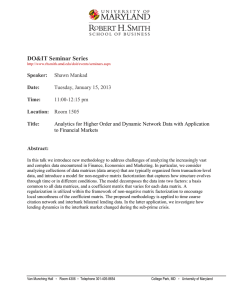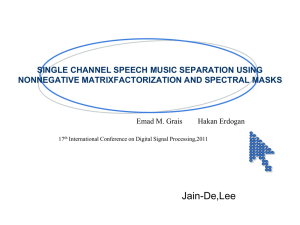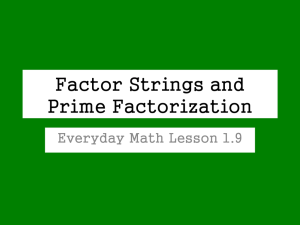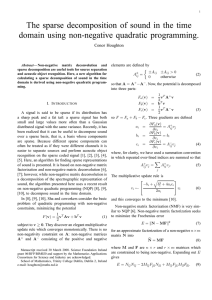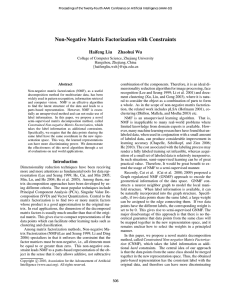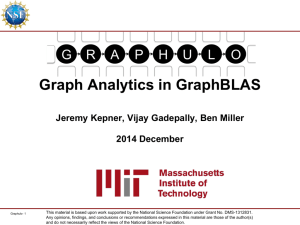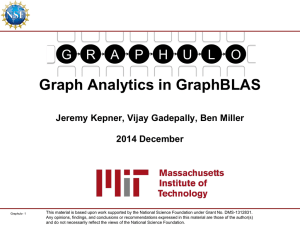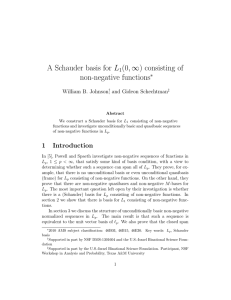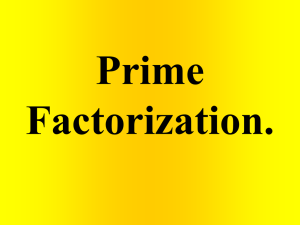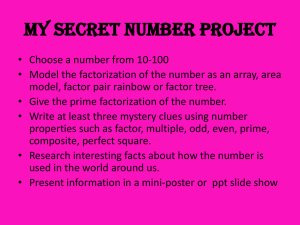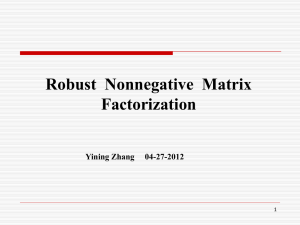Slides
advertisement
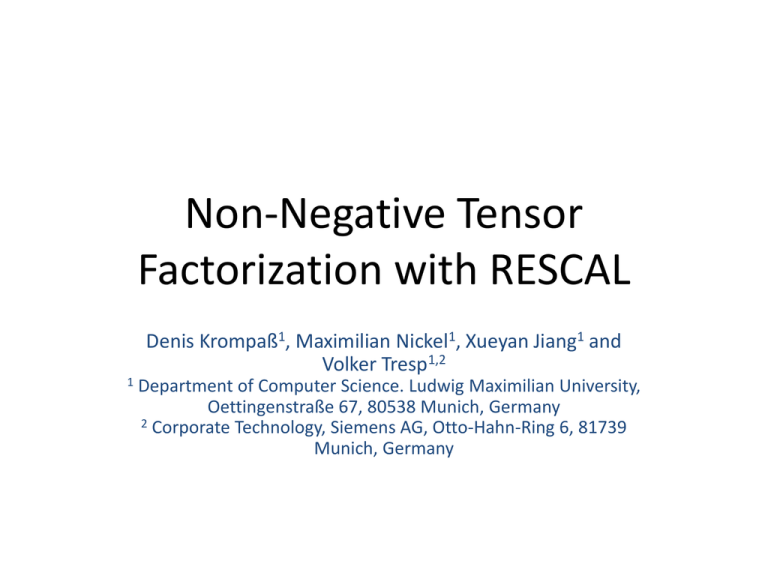
Non-Negative Tensor Factorization with RESCAL Denis Krompaß1, Maximilian Nickel1, Xueyan Jiang1 and Volker Tresp1,2 1 Department of Computer Science. Ludwig Maximilian University, Oettingenstraße 67, 80538 Munich, Germany 2 Corporate Technology, Siemens AG, Otto-Hahn-Ring 6, 81739 Munich, Germany Overview 1. 2. 3. 4. 5. 6. Non-Negative Matrix Factorization Multiplicative Updates RESCAL Non-Negativity for RESCAL Experiments Benefits and Drawbacks Non-Negative Matrix Factorization • Factorize a Matrix/Tensor into non-negative factors e.g. X = AV – Allows interpretation of latent factors – Can be directly used for clustering – Enforces sparse factors Multiplicative Updates • Introduced by Lee & Seung in 2000 • Used by Mørup and Hanson to infer NN Tucker decomposition • Define a cost-function C(θ) • Derive the partial derivative with respect to θi • Identify negative and positive part of the derivative and construct update function: C ( ) i i i C ( ) i Negative part of the derivative Positive part of the derivative RESCAL Tensor Factorization for Relational Learning • Three-way-tensor factorization model X k AR k A , for k 1,..., m T C RESCAL ( X , A , R ) X k k AR k A T 2 F A A 2 F R Rk 2 F k • Showed very good results in various relational learning tasks [5,8] Non-Negative Constraint for RESCAL • Regularized Least-Squares Cost Function C LS ( X , A , R ) f LS ( X , A , R ) f L 2 ( A , R ) f LS ( X , A , R ) X k k AR k A T 2 and F f L 2 ( A , R ) A A 2 F R Rk 2 F k • Regularized Kullback-Leibler-Divergence Cost Function C KL ( X , A , R ) f KL ( X , A , R ) f L 1 ( A , R ) X ij T f KL ( X , A , R ) X ij log X ij ( AR k A ) ij and f L 1 ( A , R ) A A 1 R R k T ( AR k A ) ij ijk k 1 Normalization and Integrating Entity Attribute Information • Normalization of Factor Matrix A [13] C * LS ( X , A , R ) f LS ~ with Air ~ ( X , A , R ) f L 1 (R ) Air Ar F • Add attribute information to the model [8] C LS ( X , A , R , D , V ) C LS ( X , A , R ) C LS a ttr ( D , A , V ) where C LS a ttr f LS a ttr ( D , A , V ) f L 2 (V ) with f LS a ttr ( D , A , V ) D AV 2 F and f L 2 (V ) V Also for KLDivergence CostFunction Include 2 F Experiments • Nations 14 x 14 x 56 multi-relational data that consist of relations between nations (treaties, immigration, etc). Additionally the dataset contains attribute information for each entry. • Kinship 104 x 104 x 26 multi-relational data that consist of several kinship relations within the Alwayarra tribe. • UMLS 135 x 135 x 49 multi relational data that consist if biomedical relationships between categorized concepts of the Unified Medical Language System (UMLS). • 10 x cross-validation • Initialized the non-negative factor matrices with Non-negative Double Singular Value Decomposition method (NNDSVD)[9] • Nonzero entries were defined as entries smaller than -1.0e-9 or greater than 1.0e-9. Results • In Kinships and UMLS case, the performance is similar to the original RESCAL • Worse performance on the nations dataset • Sparsity of latent factors significantly lower for UMLS and Kinships • Minimizing KL-Divergence Cost functions leads to more sparse factors LS KL-Divergence LS KL-Divergence Conclusion • • • • Extended non-negative matrix factorization to relational learning tasks with the RESCAL model employing multiplicative update rules. Derived update rules for Least-Squares and KL-Divergence based cost functions including: Regularization, Normalization and Attribute Information (+) Benefits: + Updates also exploit data sparsity + Little loss in predictive performance + Significant gain in sparsity of latent factor representation (-) Drawbacks: Slower convergence even after using non-random initialization of factor matrices as proposed by [9] References 1. 2. 3. 4. 5. 6. 7. 8. 9. 10. 11. 12. 13. Harshman, RA: Foundations of the PARAFAC procedure: Models and conditions for an "explanatory" multi-modal factor analysis. UCLA Working Papers in Phonetics, 16, 1-84 (1970) Carroll, JD, Chang, JJ: Analysis of individual differences in multidimensional scaling via an N-way generalization of "EckertYoung" decomposition. Psychometrika, 35, 283-319 (1970) Tucker, LR: Some Mathematical notes on three-mode factor analysis. Psychometrika, 31, 279-311 (1966) Lee, DD, Seung, H.S.: Algorithms for Non-negative Matrix Factorization. In NIPS, 556-562 (2000) Nickel, M, Tresp, V, Kriegel, HP: A Three-Way Model for Collective Learning on Multi-Relational Data. In Proceedings of the 28th International Conference on Machine Learning (2011) Wang, F, Li, P, König, AC: Efficient Document Clustering via Online Nonnegative Matrix Factorizations In Proceedings of SDM'11, 908-919 (2011) Kohen, Y: The BellKor Solution to the Netflix Grand Prize. (2009) Nickel, M, Tresp, V, Kriegel, HP: Factorizing YAGO. Scalable Machine Learning for Linked Data. In Proceedings of the 21st International World Wide Web Conference (WWW2012) (2012) Boutsidis, C, Gallopoulos, E: SVD-based initialization: A head start for nonnegative matrix factorization. Pat. Recogn. 41(4), 1350-1362 (2008) Langville, AN, Meyer, CD, Albright R: Initializations for the Nonnegative Matrix Factorization. KDD (2006) Lee, DD, Seung, HS: Learning the parts of objects by non-negative matrix factorization. Nature, 401, 788-791 (1999) Mørup, M, Hanson, LK: Algorithms for Sparse Non-negative Tucker decomposition. Neural Comput. 20(8), 2112-31 (2008) Eggert, J, Körner, E: Sparse coding and NMF. In Neural Networks, volume 4, pages 2529-2533 (2004)
